Numerical Simulation on Charge Transport and DC Breakdown in Polyethylene-Based Micro-h-BN/Nano-SiO2 with Filler Orientation Dependent Trap Energy †
Abstract
:1. Introduction
2. BCT Model
2.1. Charge Injection
2.2. Self-Consistent Equations
2.3. Charge Dynamics
3. Parameters for the BCT Model
4. Simulation Results and Discussion
4.1. Space Charge Accumulation
4.2. Electric Field Distribution
5. Conclusions
- (1)
- The density of accumulated space charge is the highest in the sample with parallel h-BN orientation, the material having filler distributed randomly follows and the lowest charge density appears as the h-BN is perpendicular to the normal vector of the composite surface.
- (2)
- The electric field in the sample is distorted due to the space charge accumulation. The factor of electric field distortion is the smallest when the h-BN has a parallel orientation, whereas the distortion of electric field is most serious in the sample with the perpendicular orientation of h-BN.
- (3)
- The breakdown of the sample most easily occurs when the h-BN has the parallel orientation, whereas the sample that has the highest breakdown strength as the h-BN with a perpendicular orientation.
Author Contributions
Funding
Institutional Review Board Statement
Informed Consent Statement
Data Availability Statement
Conflicts of Interest
References
- Chen, G.; Hao, M.; Xu, Z.; Vaughan, A.; Cao, J.; Wang, H. Review of high voltage direct current cables. CSEE J. Power Energy Syst. 2015, 1, 9–21. [Google Scholar] [CrossRef]
- Zhou, Y.; Peng, S.; Hu, J.; He, J. Polymeric insulation materials for HVDC cables: Development, challenges and future perspective. IEEE Trans. Dielectr. Electr. Insul. 2017, 24, 1308–1318. [Google Scholar] [CrossRef]
- Hanley, T.L.; Burford, R.P.; Fleming, R.J.; Barber, K.W. A general review of polymeric insulation for use in HVDC cables. IEEE Electr. Insul. Mag. 2003, 19, 13–24. [Google Scholar] [CrossRef]
- Huang, X.; Jiang, P.; Tanaka, T. A review of dielectric polymer composites with high thermal conductivity. IEEE Electr. Insul. Mag. 2011, 27, 8–16. [Google Scholar] [CrossRef]
- Huang, X.; Zhi, C.; Jiang, P.; Colberg, D.; Bando, Y.; Tanaka, T. Polyhedral oligosilsesquioxane-modified boron nitride nanotube based epoxy nanocomposites: An ideal dielectric material with high thermal conductivity. Adv. Funct. Mater. 2013, 23, 1824–1831. [Google Scholar] [CrossRef]
- Zhou, W.; Zuo, J.; Zhou, A.; Zhang, X. Thermal, electrical, and mechanical properties of hexagonal boron nitride–reinforced epoxy composites. J. Compos. Mater. 2013, 48, 2517–2526. [Google Scholar] [CrossRef]
- Zeng, X.; Yu, S.; Sun, R. Thermal behavior and dielectric property analysis of boron nitride-filled bismaleimide-triazine resin composites. J. Appl. Polym. Sci. 2013, 128, 1353–1359. [Google Scholar] [CrossRef]
- Wang, Z.; Iizuka, T.; Kozako, M.; Ohki, Y.; Tanaka, T. Development of epoxy/bn composites with high thermal conductivity and sufficient dielectric breakdown strength part I- sample preparations and thermal conductivity. IEEE Trans. Dielectr. Electr. Insul. 2012, 18, 1963–1972. [Google Scholar] [CrossRef]
- Sato, K.; Horibe, H.; Shirai, T.; Hotta, Y.; Nakano, H.; Nagai, H. Thermally conductive composite films of hexagonal boron nitride and polyimide with affinity-enhanced interfaces. J. Mater. Chem. 2010, 20, 2749–2752. [Google Scholar] [CrossRef]
- Gaska, K.; Kadar, R.; Rybak, A.; Siwek, A.; Gubanski, S. Gas barrier, thermal, mechanical and rheological properties of highly aligned graphene-ldpe nanocomposites. Polymers 2017, 9, 294. [Google Scholar]
- Tanimoto, M.; Yamagata, T.; Miyata, K.; Ando, S. Anisotropic Thermal Diffusivity of Hexagonal Boron Nitride-Filled Polyimide Films: Effects of Filler Particle Size, Aggregation, Orientation, and Polymer Chain Rigidity. ACS Appl. Mater. Interfaces 2013, 5, 4374–4382. [Google Scholar] [CrossRef] [PubMed]
- Tsekmes, I.A.; Morshuis PH, F.; Smit, J.J.; Kochetov, R. Enhancing the thermal and electrical performance of epoxy microcomposites with the addition of nanofillers. IEEE Electr. Insul. Mag. 2015, 31, 32–42. [Google Scholar] [CrossRef]
- Donnay, M.; Tzavalas, S.; Logakis, E. Boron nitride filled epoxy with improved thermal conductivity and dielectric breakdown strength. Compos. Sci. Technol. 2015, 110, 152–158. [Google Scholar] [CrossRef]
- Wang, Z.; Iizuka, T.; Kozako, M.; Ohki, Y.; Tanaka, T. Development of epoxy/bn composites with high thermal conductivity and sufficient dielectric breakdown strength partⅡ- breakdown strength. IEEE Trans. Dielectr. Electr. Insul. 2011, 18, 1973–1983. [Google Scholar] [CrossRef]
- Pourrahimi, A.M.; Olsson, R.T.; Hedenqvist, M.S. Nanocomposites: The role of interfaces in polyethylene/metal-oxide nanocomposites for ultrahigh-voltage insulating materials. Adv. Mater. 2018, 30, 1703624. [Google Scholar] [CrossRef]
- Pourrahimi, A.M.; Kumara, S.; Palmieri, F.; Yu, L.; Lund, A.; Hammarstr, T.; Hagstrand, P.; Scheblykin, L.; Fabiani, D.; Xu, X.; et al. Repurposing Poly(3-hexylthiophene) as a Conductivity-Reducing Additive for Polyethylene-Based High-Voltage Insulation. Adv. Mater. 2021, 33, 2100714. [Google Scholar] [CrossRef]
- Gaska, K.; Xu, X.; Gubanski, S.; Kadar, R. Electrical, mechanical, and thermal properties of ldpe graphene nanoplatelets composites produced by means of melt extrusion process. Polymers 2017, 9, 11. [Google Scholar]
- Koerner, H.; Jacobs, J.; Tomlin, D.; Busbee, J.; Vaia, R. Tuning polymer nanocomposite morphology: AC electric field manipulation of epoxy–montmorillonite (clay) suspensions. Adv. Mater. 2004, 16, 297–302. [Google Scholar] [CrossRef]
- Yan, H.; Tang, Y.; Long, Y.; Li, Y. Enhanced thermal conductivity in polymer composites with aligned graphene nanosheets. J. Mater. Sci. 2004, 49, 5256–5264. [Google Scholar] [CrossRef]
- Agarwal, S.; Khan, M.; Gupta, R. Thermal conductivity of polymer nanocomposites made with carbon nanofibers. Polym. Eng. Sci. 2008, 48, 2474–2481. [Google Scholar] [CrossRef]
- Shen, H.; Guo, J.; Wang, H.; Zhao, N.; Xu, J. Bioinspired modification of h-BN for high thermal conductive composite films with aligned structure. ACS Appl. Mater. Interfaces 2016, 7, 5701–5708. [Google Scholar] [CrossRef]
- Nan, W.; Su, J.; Wang, Y.; Chen, D. Fabrication of Ni@SiC composite nanofibers by electrospinning and autocatalytic electroless plating techniques. Results Phys. 2018, 12, 853–858. [Google Scholar]
- Xu, X.; Gao, Y.; Li, J.; Song, Z.; Peng, J.; Du, B. Charge Transport and DC Breakdown in Polymer Based Micro/Nano-Composite with Different Filler Orientations. In Proceedings of the 2020 IEEE International Conference on High Voltage Engineering and Application (ICHVE), Beijing, China, 6–10 September 2020; pp. 1–4. [Google Scholar]
- Min, D.; Li, S. Simulation on the influence of bipolar charge injection and trapping on surface potential decay of polyethylene. IEEE Trans. Dielectr. Electr. Insul. 2014, 21, 1627–1636. [Google Scholar] [CrossRef]
- Teyssedre, G.; Laurent, C. Charge transport modeling in insulating polymers: From molecular to macroscopic scale. IEEE Trans. Dielectr. Electr. Insul. 2005, 12, 857–875. [Google Scholar] [CrossRef]
- Laurent, C.; Teyssedre, G.; Roy, S.; Baudoin, F. Charge dynamics and its energetic features in polymeric materials. IEEE Trans. Dielectr. Electr. Insul. 2013, 20, 357–381. [Google Scholar] [CrossRef]
- Li, S.; Zhu, Y.; Min, D.; Chen, G. Space charge modulated electrical breakdown. Sci. Rep. 2016, 6, 32588. [Google Scholar] [CrossRef] [PubMed] [Green Version]
- Roy, S.; Teyssedre, G.; Laurent, C.; Montanari, G.; Palmieri, F. Description of charge transport in polyethylene using a fluid model with a constant mobility: Fitting model and experiments. J. Phys. D Appl. Phys. 2006, 39, 1427. [Google Scholar] [CrossRef]
- Chen, G.; Zhao, J.; Li, S.; Zhong, L. Origin of thickness dependent DC electrical breakdown in dielectrics. Appl. Phys. Lett. 2012, 100, 2135. [Google Scholar] [CrossRef] [Green Version]
- Li, S.; Min, D.; Wang, W.; Chen, G. Modelling of dielectric breakdown through charge dynamics for polymer nanocomposites. IEEE Trans. Dielectr. Electr. Insul. 2016, 23, 3476–3485. [Google Scholar] [CrossRef]
- Hoang, A.T.; Serdyuk, Y.V.; Gubanski, S.M. Charge transport in LDPE nanocomposites Part II—Computational approach. Polymers 2016, 8, 103. [Google Scholar]
- Kuik, M.; Koster, L.; Dijkstra, A.; Wetzelaer, G.; Blom, P. Non-radiative recombination losses in polymer light-emitting diodes. Org. Electron. 2012, 13, 969–974. [Google Scholar] [CrossRef] [Green Version]
- Shockley, W.; Read, W. Statistics of the recombinations of holes and electrons. Phys. Rev. 1952, 87, 835–842. [Google Scholar] [CrossRef]
- Gao, Y.; Xu, B.; Wang, X.; Jia, T. Charge transport in low density polyethylene based micro/nano-composite with improved thermal conductivity. J. Phys. D Appl. Phys. 2019, 52, 285302. [Google Scholar] [CrossRef]
- Min, D.; Li, Y.; Yan, C.; Xie, D.; Li, S.; Wu, Q.; Zhao, Z. Thickness-Dependent DC electrical breakdown of polyimide modulated by charge transport and molecular displacement. Polymers 2018, 10, 1012. [Google Scholar] [CrossRef] [Green Version]
- Min, D.; Cui, H.; Wang, W.; Wu, Q.; Zhao, Z.; Li, S. The coupling effect of interfacial traps and molecular motion on the electrical breakdown in polyethylene nanocomposites. Compos. Sci. Technol. 2019, 184, 107873. [Google Scholar] [CrossRef]
- Xie, D.; Min, D.; Yang, L.; Li, S. Temperature- and thickness-dependent electrical breakdown modulated by a coupling model of charge transport and molecular chain dynamics. J. Phys. D Appl. Phys. 2019, 52, 365305. [Google Scholar] [CrossRef]
- Min, D.; Li, S.; Ohki, Y. Numerical simulation on molecular displacement and dc breakdown of LDPE. IEEE Trans. Dielectr. Electr. Insul. 2016, 23, 507–516. [Google Scholar] [CrossRef]
- Bhutta, M.; Yang, L.; Ma, Z.; Nazir, M.; Akram, S.; Mehmood, M.; Faiz1, N. Simulation of thickness controlled dc breakdown of XLPE regulated by space charge & molecular chain movement. IEEE Trans. Dielectr. Electr. Insul. 2020, 27, 1143–1151. [Google Scholar]
- Frenkel, J. On pre-breakdown phenomena in insulators and electronic semi-conductors. Phys. Rev. 1938, 54, 647–648. [Google Scholar] [CrossRef]
- Wu, K.; Dissado, L.A.; Okamoto, T. Percolation model for electrical breakdown in insulating polymers. Appl. Phys. Lett. 2004, 85, 4454–4456. [Google Scholar] [CrossRef] [Green Version]
- Wang, W.; Li, S. Correlation between trap parameters and breakdown strength of polyethylene/alumina nanocomposites. In Proceedings of the 2014 International Symposium on Electrical Insulating Materials (ISEIM), Niigata, Japan, 1–5 June 2014; pp. 73–76. [Google Scholar]
- Tanaka, T.; Wang, Z.; Iizuka, T.; Kozako, M.; Ohki, Y. High thermal conductivity epoxy/BN composites with sufficient dielectric breakdown strength. In Proceedings of the 2011 Annual Report Conference on Electrical Insulation and Dielectric Phenomena (CEIDP), Cancun, Mexico, 16–19 October 2011; pp. 691–694. [Google Scholar]
- Wang, W.; Li, S.; Min, D. Understanding the conduction and breakdown properties of polyethylene nanodielectrics: Effect of deep traps. IEEE Trans. Dielectr. Electr. Insul. 2016, 23, 564–572. [Google Scholar] [CrossRef]
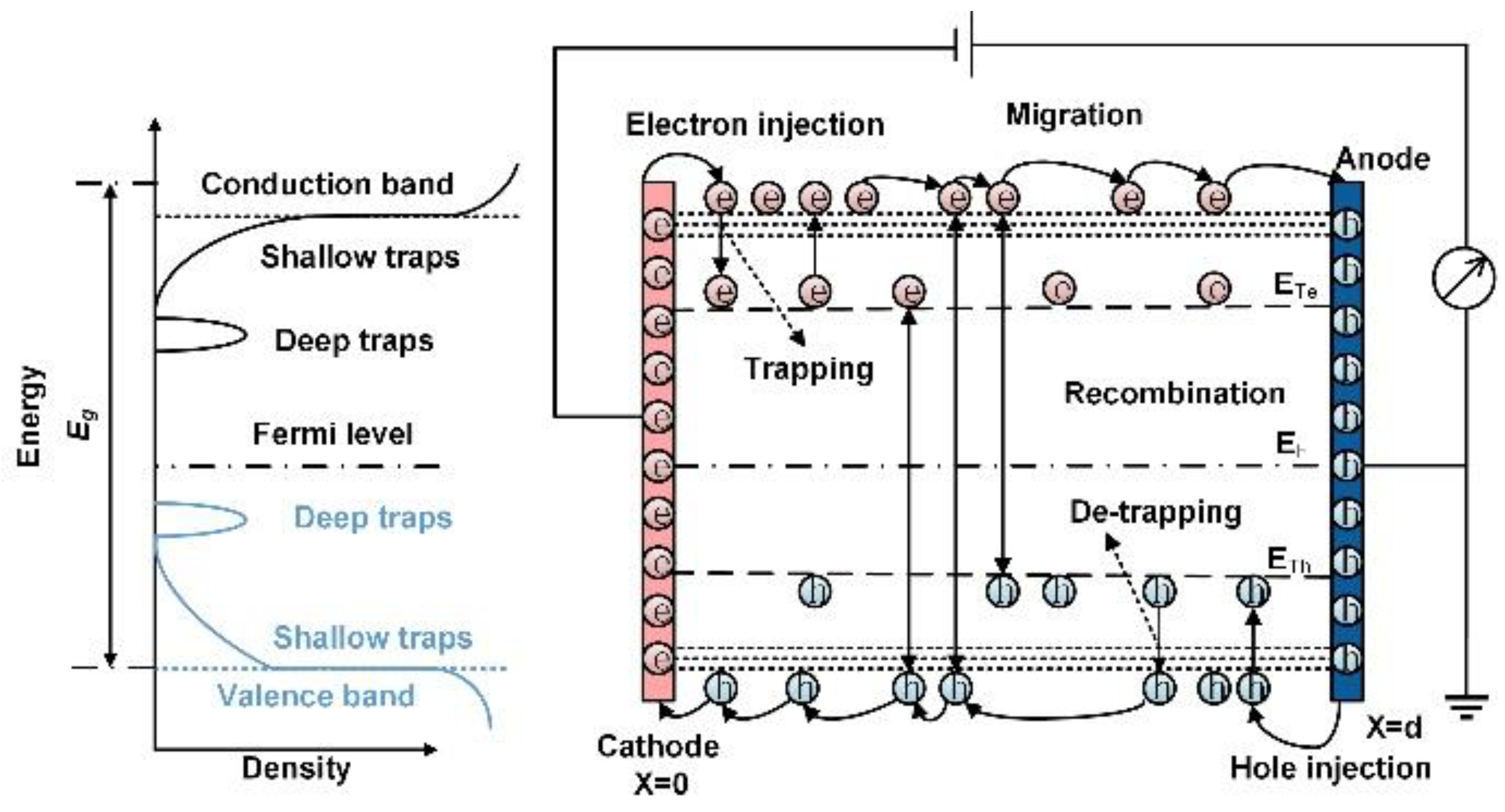
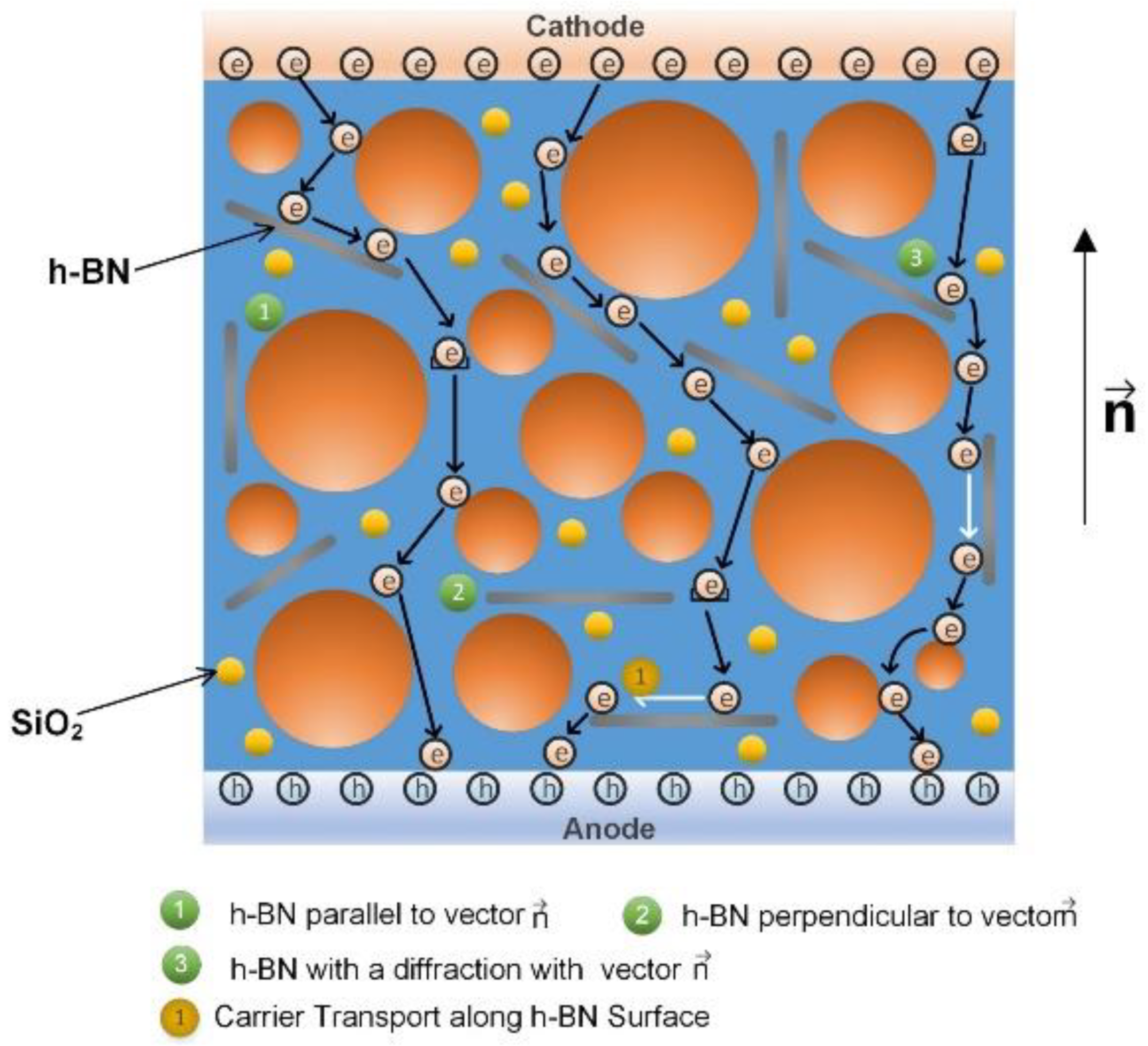


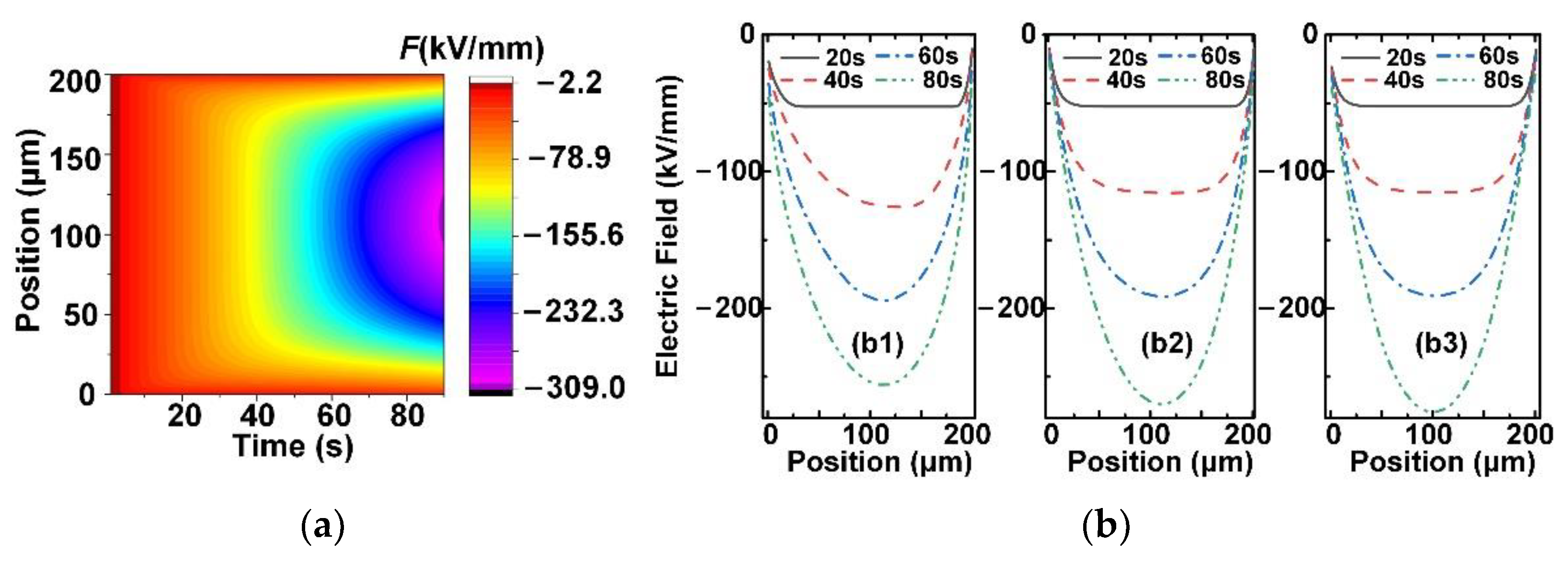
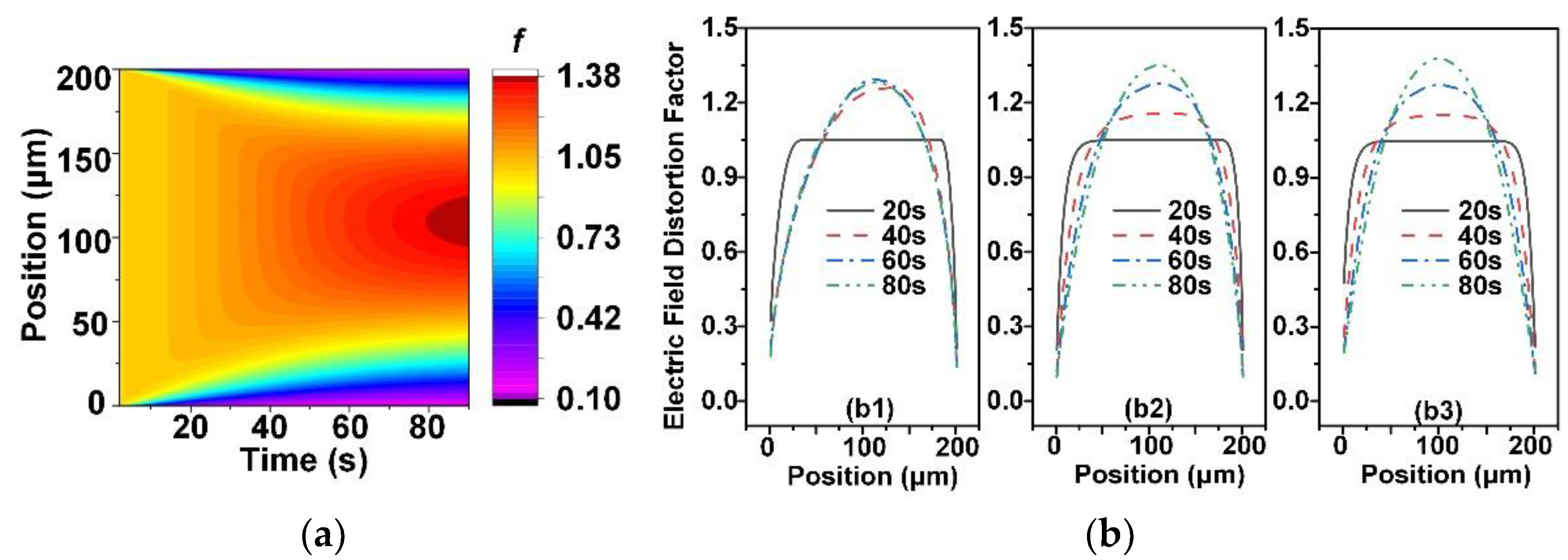
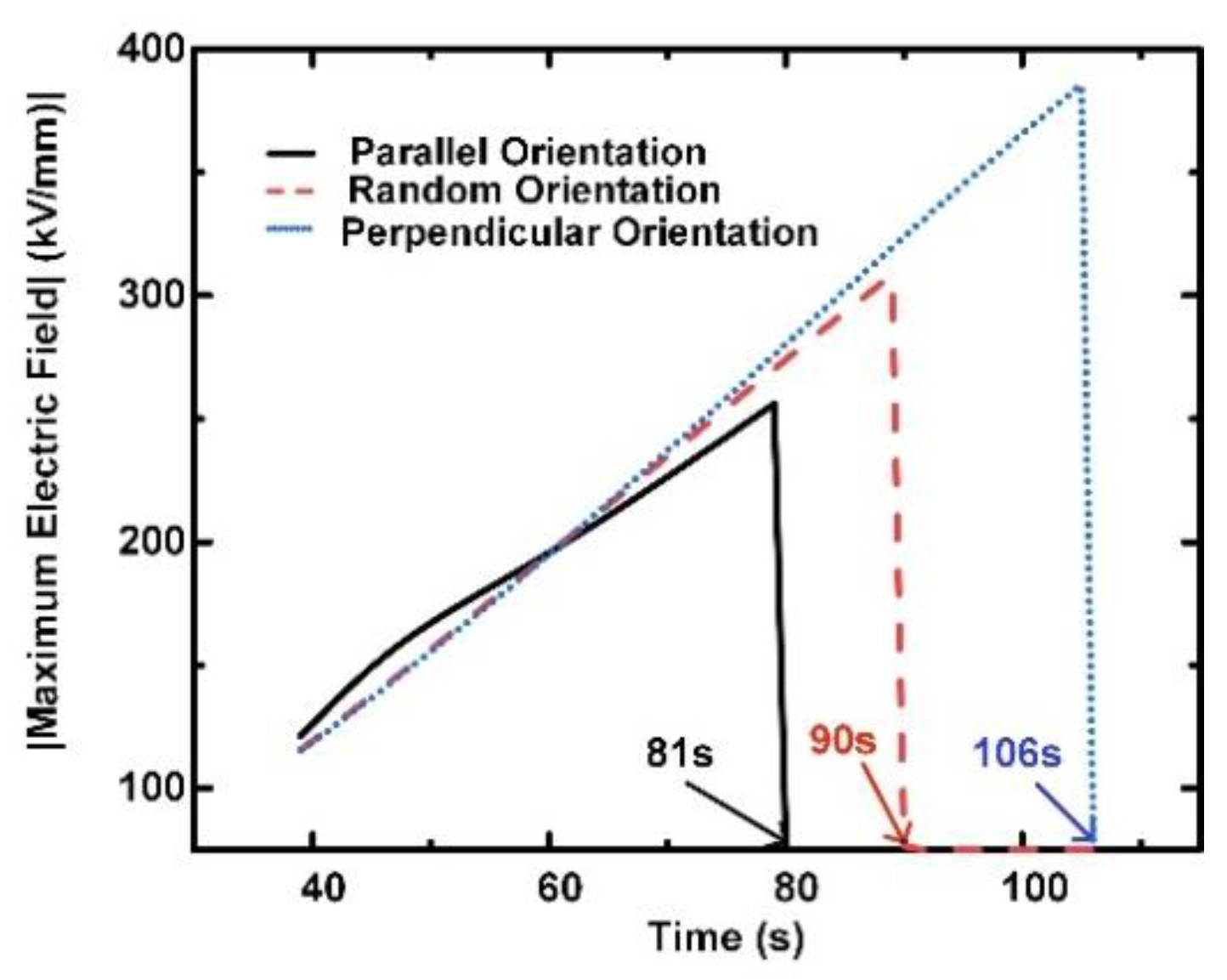

| Parameters | Value |
|---|---|
| Relative permittivity, εr | 2.3 |
| Carrier mobility for electron, μemol, (×10−15 m2/Vs) | 8–9 |
| Carrier mobility for hole, μhmol, (×10−15 m2/Vs) | 2–3 |
| Trap energy for electron, ETe, (eV) | 0.7–1 |
| Trap energy for hole, ETh, (eV) | 0.7–1 |
| Trap density for electron, NTe, (1/m3 ) | 6.25 × 1020 |
| Trap density for hole, NTh, (1/m3 ) | 6.25 × 1020 |
| Ramping rate of the voltage, kramp, (kV/s) | −0.5 |
Publisher’s Note: MDPI stays neutral with regard to jurisdictional claims in published maps and institutional affiliations. |
© 2021 by the authors. Licensee MDPI, Basel, Switzerland. This article is an open access article distributed under the terms and conditions of the Creative Commons Attribution (CC BY) license (https://creativecommons.org/licenses/by/4.0/).
Share and Cite
Xu, X.; Gao, Y.; Li, J.; Song, Z.; Zhao, H.; Han, T. Numerical Simulation on Charge Transport and DC Breakdown in Polyethylene-Based Micro-h-BN/Nano-SiO2 with Filler Orientation Dependent Trap Energy . Energies 2021, 14, 4645. https://doi.org/10.3390/en14154645
Xu X, Gao Y, Li J, Song Z, Zhao H, Han T. Numerical Simulation on Charge Transport and DC Breakdown in Polyethylene-Based Micro-h-BN/Nano-SiO2 with Filler Orientation Dependent Trap Energy . Energies. 2021; 14(15):4645. https://doi.org/10.3390/en14154645
Chicago/Turabian StyleXu, Xuri, Yu Gao, Jing Li, Zheng Song, Huicun Zhao, and Tao Han. 2021. "Numerical Simulation on Charge Transport and DC Breakdown in Polyethylene-Based Micro-h-BN/Nano-SiO2 with Filler Orientation Dependent Trap Energy " Energies 14, no. 15: 4645. https://doi.org/10.3390/en14154645
APA StyleXu, X., Gao, Y., Li, J., Song, Z., Zhao, H., & Han, T. (2021). Numerical Simulation on Charge Transport and DC Breakdown in Polyethylene-Based Micro-h-BN/Nano-SiO2 with Filler Orientation Dependent Trap Energy . Energies, 14(15), 4645. https://doi.org/10.3390/en14154645








